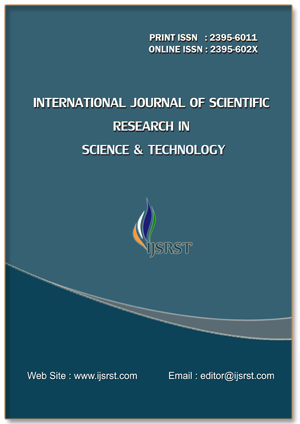Pancreatic Tumor Detection Using Image Processing
DOI:
https://doi.org/10.32628/IJSRST251222650Keywords:
Deep Learning, Medical Image, Pancreatic Tumor Detection, Flask, Convolutional Neural Networks, Pancreatic Ductal AdenocarcinomaAbstract
Pancreatic tumor is one of the most life-threatening cancers, often diagnosed at advanced stages due to the absence of early symptoms and the lack of effective screening techniques. This project aims to develop an efficient and accurate computer-aided detection (CAD) system for pancreatic tumor identification using advanced image processing techniques. Utilizing a publicly available dataset from Kaggle consisting of CT and MRI scans, the system employs a 3D Convolutional Neural Network (3D CNN)-based approach to automate tumor detection. Image pre-processing techniques such as resizing for uniform input dimensions, normalization to standardize pixel intensity, and data augmentation to enhance dataset diversity are applied to improve feature extraction and reduce overfitting. The model achieved an accuracy of 99%, demonstrating high efficacy in detecting pancreatic tumors. Additionally, domain adaptation techniques were implemented to enhance generalization across different imaging modalities. The application is developed using Tkinter for its simplicity and efficient integration with the machine learning model, offering a lightweight, local, and user-friendly interface for real-time analysis in clinical settings. This system not only supports early and accurate detection but also aids clinicians in making timely decisions, potentially improving patient outcomes. The application is developed using Tkinter for its simplicity and ease of creating a lightweight, local, and user-friendly interface. This choice allows for seamless integration with the backend machine learning model, providing a quick and efficient way for clinicians to analyse medical scans. Unlike web frameworks like Django, Tkinter eliminates the need for server-side deployment, making the tool more accessible and faster for real-time usage in clinical settings.
📊 Article Downloads
References
Simonyan, K., & Zisserman, A. (2014). Describe the VGGNet architecture, known for its depth and simplicity, contributing to efficient feature extraction in medical image processing tasks.
Ravindra Changala, "Next-Gen Human-Computer Interaction: A Hybrid LSTM-CNN Model for Superior Adaptive User Experience", 2024 Third International Conference on Electrical, Electronics, Information and Communication Technologies (ICEEICT), ISBN:979-8-3503-6908-3, DOI: 10.1109/ICEEICT61591.2024.10718496, October 2024, IEEE Xplore.
Ravindra Changala, "Enhancing Early Heart Disease Prediction through Optimized CNN-GRU Algorithms: Advanced Techniques and Applications", 2024 Third International Conference on Electrical, Electronics, Information and Communication Technologies (ICEEICT), ISBN:979-8-3503-6908-3, DOI: 10.1109/ICEEICT61591.2024.10718395, October 2024, IEEE Xplore.
Ravindra Changala, "Sentiment Analysis in Mobile Language Learning Apps Utilizing LSTM-GRU for Enhanced User Engagement and Personalized Feedback", 2024 Third International Conference on Electrical, Electronics, Information and Communication Technologies (ICEEICT), ISBN:979-8-3503-6908-3, DOI: 10.1109/ICEEICT61591.2024.10718406, October 2024, IEEE Xplore.
Ioffe, S., & Szegedy, C. (2015). Discuss batch normalization techniques that accelerate deep network training, essential for optimizing large-scale models used in tumor detection.
Ravindra Changala, "Image Classification Using Optimized Convolution Neural Network", 2024 Parul International Conference on Engineering and Technology (PICET), ISBN:979-8-3503-6974-8, DOI: 10.1109/PICET60765.2024.10716049, October 2024, IEEE Xplore.
Li, H., Giger, M. L., Lan, L., et al. (2015). "Computerized Texture Analysis of Pulmonary Nodules for Classification." Medical Physics, 42(1), 44-52. Demonstrates the role of texture analysis in distinguishing tumor types, applicable to pancreatic image processing.
Ravindra Changala, "Implementing Genetic Algorithms for Optimization in Neuro-Cognitive Rehabilitation Robotics", 2024 International Conference on Cognitive Robotics and Intelligent Systems (ICC - ROBINS), ISBN:979-8-3503-7274-8, DOI: 10.1109/ICC-ROBINS60238.2024.10533965, May 2024, IEEE Xplore.
Ravindra Changala, "Monte Carlo Tree Search Algorithms for Strategic Planning in Humanoid Robotics", 2024 International Conference on Cognitive Robotics and Intelligent Systems (ICC - ROBINS), ISBN:979-8-3503-7274-8, DOI: 10.1109/ICC-ROBINS60238.2024.10533937, May 2024, IEEE Xplore.
LeCun, Y., Bengio, Y., & Hinton, G. (2015). Provide foundational knowledge on deep learning principles, crucial for understanding advanced model development for tumor detection systems.
Kingma, D. P., & Ba, J. (2015). Introduce the Adam optimizer, widely adopted in training deep learning models, ensuring efficient and stable learning processes.
He, K., Zhang, X., Ren, S., & Sun, J. (2016). Introduce the ResNet architecture, which is instrumental in building deeper and more accurate neural networks for image analysis.
Xu, Z., Li, H., & Chan, T. F. (2017). Explore regularization techniques in image segmentation, which are essential for minimizing errors and enhancing the clarity of tumor boundaries in medical imaging.
Ravindra Changala, "Image Classification Using Optimized Convolution Neural Network", 2024 Parul International Conference on Engineering and Technology (PICET), ISBN:979-8-3503-6974-8, DOI: 10.1109/PICET60765.2024.10716049, October 2024, IEEE Xplore.
Chen, J., Li, W., & Hu, Y. (2020). Introduce dual-path networks for medical image segmentation, offering methods for improving context awareness and detection precision.
Wang, G., Li, W., Zuluaga, M. A., et al. (2018). Present automated segmentation approaches using deep learning, emphasizing the need for robust data processing pipelines in medical imaging tasks.
Ravindra Changala, "Deep Learning Techniques to Analysis Facial Expression and Gender Detection", 2023 International Conference on New Frontiers in Communication, Automation, Management and Security (ICCAMS), ISBN:979-8-3503-1706-0, DOI: 10.1109/ICCAMS60113.2023.10525942, May 2024, IEEE Xplore.
Ravindra Changala, Brain Tumor Detection and Classification Using Deep Learning Models on MRI Scans”, EAI Endorsed Transactions on Pervasive Health and Technology, Volume 10, 2024.
Ravindra Changala, Development of Predictive Model for Medical Domains to Predict Chronic Diseases (Diabetes) Using Machine Learning Algorithms and Classification Techniques, ARPN Journal of Engineering and Applied Sciences, Volume 14, Issue 6, 2019.
Downloads
Published
Issue
Section
License
Copyright (c) 2025 International Journal of Scientific Research in Science and Technology

This work is licensed under a Creative Commons Attribution 4.0 International License.
https://creativecommons.org/licenses/by/4.0




